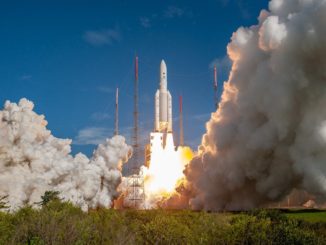The first images from the European-built Solar Orbiter mission are the closest ever taken of the sun, revealing previously unseen mini-flares nicknamed “campfires” that may offer hints about what makes the solar corona, or outer atmosphere, hotter than the sun’s surface.
The European Space Agency-led Solar Orbiter mission, built and launched in partnership with NASA, will become the first spacecraft to take pictures of the sun’s polar regions. But Solar Orbiter is already setting records months after its launch Feb. 9 from Cape Canaveral aboard a United Launch Alliance Atlas 5 rocket.
The first images from the Solar Orbiter spacecraft revealed new processes at work on the sun. Scientists noticed widespread miniature solar flares, which appear to be smaller versions of solar eruptions that are visible from Earth.
The science team nicknamed the mini-flares “campfires,” one of several new terms coined by the Solar Orbiter team as researchers sift through rich data sets now being returned by the spacecraft’s 10 instruments.
“When you look at it in high resolution, it’s amazing, in the smallest details, how much stuff is going on there,” said David Berghmans, principal investigator for Solar Orbiter’s Extreme Ultraviolet Imager from the Royal Observatory of Belgium.
“We couldn’t believe this when we first saw this, and we started giving it crazy names like campfires and dark fibrils and ghosts and whatever we saw,” Berghmans said in a press conference Thursday. “There is so much new small phenomena going on, on the smallest scales, that we are starting a new vocabulary to give it new names.”
Berghmans said the imagery from the Extreme Ultraviolet Imager — an instrument package on Solar Orbiter containing three different telescopes — will improve in contrast and sharpness as scientists optimize image processing software and as the spacecraft moves closer to the sun.
The images released Thursday by the European Space Agency and NASA were taken as Solar Orbiter passed its first perihelion — the point in its elliptical orbit closest to the sun — at a distance of about 48 million miles (77 million kilometers). That is about half of Earth’s distance from the sun, and just outside of Mercury’s orbit.
No other solar telescopes has observed the sun from such a close distance, but the images will get better as Solar Orbiter moves closer to the sun in the coming years.
“To our knowledge, many of these spectacular features have not been observed before at this scale,” said Daniel Müller, ESA’s project scientist for the Solar Orbiter mission. “These are clearly just the test images, so it’s too early to draw any scientific conclusions, but our conjecture is that these campfires and ghosts are related to changes in the sun’s magnetic field, a process that is known as magnetic reconnection.”
“These (magnetic fields) do get tangled and do get stressed, and like rubber bands, they can eventually tear and then reconfigure into new configurations,” Müller said. “That tearing process can release energy of vast quantities, and that can then heat the plasma locally to temperatures of more than a million degrees, which is what we see in the EUI images.”
The Extreme Ultraviolet Imager instrument includes three telescopes, each tuned to look at a different layer on the sun. The campfires appeared in images looking at the sun’s lower atmosphere, or corona, where temperatures exceed a million degrees Celsius, or 1.8 million degrees Fahrenheit.
Solar Orbiter carries six remote sensing instruments to take pictures of the sun, and another four instruments collect in situ data on the environment around the spacecraft.

“The campfires are little relatives of the solar flares that we can observe from Earth, million or billion times smaller,” Berghmans said in a statement. “The sun might look quiet at the first glance, but when we look in detail, we can see those miniature flares everywhere we look.”
Berghmans said the smallest of the campfires appear to be a few hundred miles across, or “about the size of a European country.” Smaller campfires may become visible later in the Solar Orbiter mission, when the spacecraft’s orbit shifts closer to the sun.
The solar corona extends millions of miles into space, in a region where temperatures soar much hotter than the sun’s surface, which averages around 10,000 degrees Fahrenheit (5,500 degrees Celsius).
“It’s a little counterintuitive because you would think that if you have a body that’s very hot at the center, and relatively cool at the surface, it would be even cooler the farther you go away,” Müller said. “But on the contrary, for the sun, we have a hot core a relatively cool surface … surrounded by a super-hot atmosphere of more than a million degrees.”
Eugene Parker, a pioneering U.S. solar physicist who theorized the solar wind before scientists confirmed its existence, predicted that the solar corona might be heated by numerous tiny flares invisible to solar telescopes around Earth.
“These campfires are totally insignificant each by themselves, but summing up their effect all over the sun, they might be the dominant contribution to the heating of the solar corona,” says Frédéric Auchère, of the Institut d’Astrophysique Spatiale in France, co-investigator on the Extreme Ultraviolet Imager.
Since its launch in February, Solar Orbiter and its 10 instruments have been tested, calibrated and confirmed ready for science operations. The $1.5 billion mission’s post-launch commissioning proceeded mostly on schedule despite significant disruptions from the coronavirus pandemic.
Solar Orbiter operations stopped for around 10 days in March after an employee at ESA’s mission operations center in Germany tested positive for COVID-19. Limited personnel were allowed back the ESA control center, but instrument teams across Europe had to verify the performance of Solar Orbiter’s science payload from home.

While ESA leads the Solar Orbiter mission, NASA paid for the probe’s launch, and there is one U.S.-led instrument on the spacecraft.
With the launch of Solar Orbiter, scientists have two spacecraft observing the sun from locations closer than any previous mission.
NASA’s Parker Solar Probe launched in August 2018 on a trajectory that takes it closer to the sun than Solar Orbiter. But Solar Orbiter carries cameras and telescopes, while Parker flies so close to the sun that scorching temperatures could damage, or destroy, sensitive imaging sensors.
And Solar Orbiter will eventually circle the sun at a higher tilt than Parker, allowing views of the sun’s poles.
The 10 instruments on Solar Orbiter will allow scientists to connect what they see happening on the sun with effects on the environment around the spacecraft.
“Most of the big headline goals — the novel parts of the mission – -rely on us all working together, and being able to link the images of the dynamics on the sun with what is coming out past the spacecraft,” said Christopher Owen, principal investigator for Solar Orbiter’s Solar Wind Analyzer instrument from University College London.
Scientists are eager to try to link the mini-solar flares, or campfires, with magnetic field data to search for what causes the eruptions. Solar Orbiter could also collect data on the origin of larger flares, which can trigger outbursts in the solar wind that can affect space weather and drive geomagnetic storms at Earth, disturbances that can impact radio communications, satellite operations and electrical grids.
The sun is currently in a relatively quiet period in its 11-year cycle. By the time Solar Orbiter moves closer to the sun, our nearest star is forecast to be more active.

After a picture-perfect, on-target launch in February, Solar Orbiter is on course for an encounter with Venus on Dec. 26 to begin nudging the spacecraft closer to the sun. Solar Orbiter will have nine planetary flybys through 2030 — eight with Venus and one with Earth — to steer the spacecraft into ever-tighter orbits around the sun.
“In March 2022, we will have the first really close flyby, when we are at 30 percent distance of the sun to the Earth,” Müller said.
“We will gradually incline our orbit to see the polar regions for the first time,” Müller said. “That will be the last change of perspective, and it’s definitely worth waiting because we really believe this will give us a lot of new insight into the sun’s activity cycle. So what ultimately drives these 11-year periodic changes in the magnetic field activity of the sun?”
The first good look at the sun’s poles will come in 2025, when Solar Orbiter reaches a trajectory angled at 17 degrees to the ecliptic plane, the plane in which the solar system’s planets are located. Repeated flybys with Venus will gradually ratchet up the probe’s inclination, or orbital tilt, thanks to the planet’s gravity.
By 2029, after the end of Solar Orbiter’s primary mission phase, the spacecraft should be in an orbit inclined more than 33 degrees to the ecliptic plane, enabling even better views of the sun’s poles.
Email the author.
Follow Stephen Clark on Twitter: @StephenClark1.



